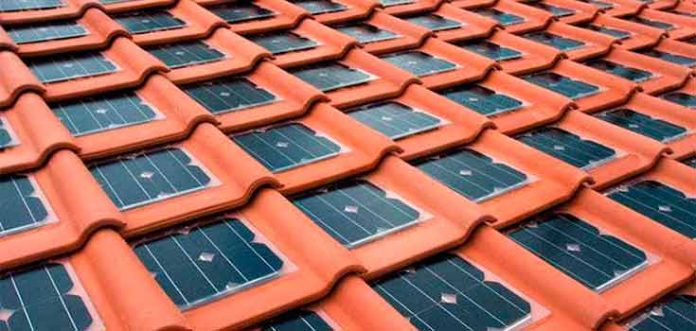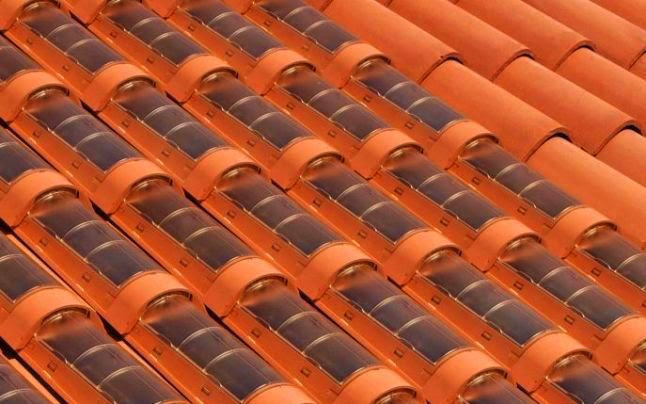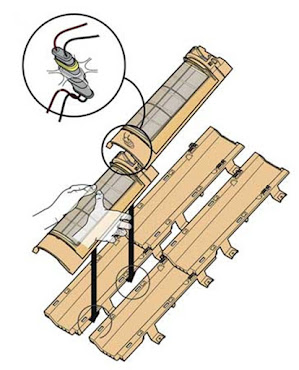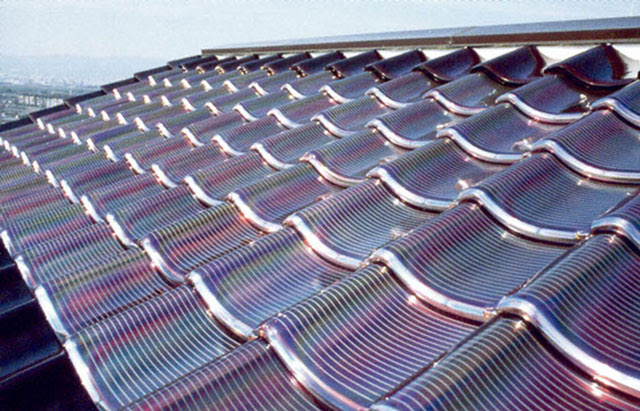
It is not new, although it has been intensifying for a few years now, the investment in R&D by numerous companies aimed at finding and obtaining energy sources that cause the least possible impact on the environment, therefore focusing much part of their efforts and resources in the renewable energy.
Among other ways of capturing and transforming clean energy, there are the photovoltaic roof tiles. A revolutionary invention at both aesthetic as well as effective, since the results obtained are undeniable.

Image: energiaextremadura.com
Various European and American companies have developed, and continue to do so, different models suitable for installation on virtually any type of roof.

Image: arkigrafico.com
This new system seeks the integration of a photovoltaic panel in the same space as a traditional tile.
A roof that, in addition to its main function, makes it possible to generate enough electricity to supply, if not completely, then to a large extent, the needs of an average family, is an option to seriously consider.
This technology is an alternative to traditional solar panels, surpassing the latter due to its impeccable aesthetics, being so discreet that it is practically invisible.
Despite this, this system is practically to be introduced in Spain. Contrary to what happens in some European countries, whose use is quite widespread.
Image: rbm-baumat.es
There is a wide variety of solar tiles depending on the shape, size, materials used, as well as the way they are installed. In this last aspect, the most used ways to achieve this integration are two:
Photovoltaic panels mounted on the original roof. This is achieved with a flexible material, such as amorphous or monocrystalline silicon plates, which allow them to adapt to the shape of the tile.
Roof tiles manufactured with the photovoltaic plate already integrated, are the system to which we have referred. These tiles are made of simple and transparent glass, and are mounted on a black nylon canvas that allows heat absorption. They have designs that range from the most traditional to the most avant-garde.

Image: tectonica-online.com
Since all that glitters is not gold, we will now analyze the advantages and disadvantages of this system. Although it is true, many of the points that we will see coincide with those of traditional solar panels.
Advantages of photovoltaic tiles
- Aesthetic and physical adaptation to roofs. Such is the adaptation that is achieved that, literally, it blends in with the environment of the roof.
- They make it possible to save money on electricity and gas bills.
- They are completely safe, since they provide perfect insulation to the roof. Exactly the same as traditional tiles.
- It is much more difficult to steal than traditional solar panels. It doesn’t take the same time to unscrew and remove a solar panel no matter how big it is; to disassemble, tile by tile, an entire roof.
- The energy generated is accumulated and stored in batteries.
- The glass used to manufacture it is easy to recycle, durable, and its production does not entail an excessive carbon footprint.
- Supports partial repairs. If a tile is damaged, it can be replaced by another without affecting the rest of the set.
- Its installation does not differ at all from that used for normal tiles.
- Being completely independent of the construction structure, it can be installed on an existing roof. Therefore, it is not necessary to take into account the possible installation of the photovoltaic roof when designing the construction of the building.
- It does not produce overloads in the structure of the building, since the weight of the photovoltaic tiles is very similar to that of traditional tiles.
- They can be placed both on sloping roofs and on those that do not have such a good orientation. Obviously, the better the orientation, the more efficient the performance of this technology will be.
Image:arquitecturayempresa.es
Disadvantages of solar roofs
- It is a technology, at the moment, more expensive than solar panels. Once it is fully introduced and its widespread use, it is logical that prices normalize.
- It requires a strong initial investment.
- It is currently a technology under development. Therefore, there are few professionals who, at the moment, are fully dedicated to this type of installation.
- Cleaning and maintenance of each module is more complicated, and therefore more expensive, compared to cleaning a single solar panel.
- They lack variable orientation, in order to make optimal use of the sun’s rays.
Image: todoensolar.com
The work being carried out by an Italian company that produces injection molded plastic solar roof tiles is noteworthy, and that contain photovoltaic cells or solar thermal modules whose function is, in this case, to heat water.
Another remarkable aspect of these plastic tiles is that they produce an optical effect perfectly simulating traditional clay tiles.
And, of course, they fulfill the main mission of any tile: the protection of the roof and the insulation of the house from the different atmospheric and meteorological agents.
The number of tiles to install will depend mainly on three aspects:
On the one hand, the surface that our cover has.
On the other, the energy needs we have. The greater the number of tiles, the greater the electricity production capacity.
And, how could it be otherwise, the budget that we can allocate to this project.



